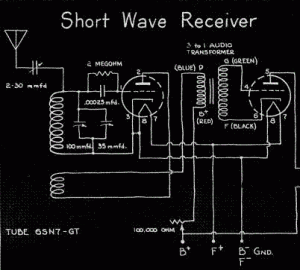I found an interesting construction article for a one-tube regenerative receiver in the September 1950 issue of Boys Life magazine. (From this link, you’ll need to scroll down to page 56 to read the article.) The authors are listed as Fred Roden and Glenn A. Wagner, and it reports the receiver in use at Albany, NY, where it picked up London, England, “clear and strong.” According to the 1952 Call Book, Roden was W2KED. He’s also listed as trustee of a Colubmia High Radio Club, W2OML, in East Greenbush, N. Y. Wagner seems to have been an author of many hobby articles for Boys Life, but I couldn’t find any indication that he was a licensed ham.
The article was a bit short on construction details, and at least one of them was wrong. According to an editor’s note (by Pedro, of course) in the November issue (page 3), there should be a connection between pins 6 and 8 of the tube. And there are no operating details explaining how to get the radio to come to life. Interestingly, the regeneration control is identified as a “volume” control, with no instructions on how to operate it. I would have thought that the lack of details would have proved frustrating to many scouts who tried to make this receiver. But according to the Pedro’s November editor’s note, many of them noticed the error in the schematic. And the caption on the schematic indicates that “any good radio repairman or electrician can give you valuable assistance in assembling the materials.”
The circuit uses a single 6SN7 dual triode. One half is used as the regenerative detector, and the other half is used as an audio amplifier. The two stages are coupled with an audio transformer, and it provides enough output to drive a pair of headphones. From the coil dimensions, I’m guessing that the receiver covered about 3-6 MHz.
The circuit is virtually identical to the one appearing in the 1950 handbook, which is available online at this link. It’s also very similar to the AA8V Twinplex Regenerative Receiver, with a couple of exceptions. The AA8V design uses a capacitor rather than a transformer to couple the two stages, and also includes a separate volume control, in addition to the regeneration control. AA8V uses a metal chassis, whereas both Boys Life and the Handbook mount the components on a board, with a metal front panel. The Handbook version calls for a power supply of 180 volts. The Boys Life version calls for a 45 volt B battery. This could easily be supplied by five 9-volt batteries in series. The Boys Life version runs the filament with a filament transformer, which the Scout can plug right in to the household current. I’m guessing that the current version of the Guide to Safe Scouting would nix this idea, but four D cells in series should be adequate to supply the filament voltage. The plate current for a receiver of this type is quite low, so the 9 volt batteries should last a long time. If you use flashlight batteries for the filament voltage, you might go through those rather quickly.
Here’s a video of what appears to be the Handbook version in operation. From its location in GI, it’s pulling in a DL calling CQ TEST in some contest. In short, you can do quite a bit with one tube, even if you were a Boy Scout 63 years ago!
The parts should be easily obtainable. You can get “new old stock” tubes at places such as Antique Electronic Supply. In addition, the 6SN7 is one of the “audiophile” tubes still being manufactured in Russia and China
. This audio transformer should be close enough if you want to stick to the Boys Life/Handbook version. Otherwise, you can go with the AA8V design, which seems to use only readily available components.


Hi Richard. At the Brimfield Antique Show in Brimfield, MA several days ago, I found and bought a built up 6SN7 regen receiver. I thought it was the 1950 ARRL version until I noticed a variation. A little Goggling got me here to your blog. My radio is not the ARRL version buy may be the Boy’s Life version.
If you’re interested I can send you some pictures.
73,
Jon WS1K
I built that receiver when I was 15 years old! It got me started in ham radio when I was 15 yrs. and got
call sign W5TCH. Now active for 65 years using an Icom Pro 3. Allen
Pingback: A 1950-Era One Tube Radio | OneTubeRadio.com
Pingback: 1934 One Tube Radio | OneTubeRadio.com
Pingback: Another 1950 Boys’ Life One Tube Receiver | OneTubeRadio.com